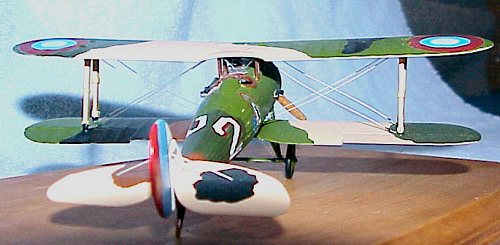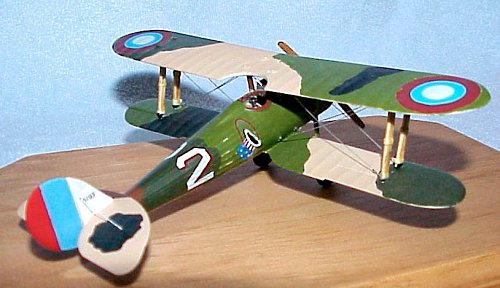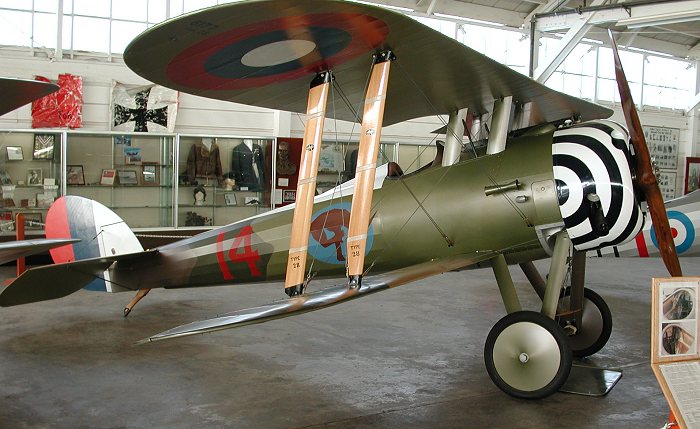
Glencoe 1/48 Nieuport 28C.1
|
KIT # |
? |
|
PRICE: |
$11.50 |
|
DECALS: |
Four aircraft |
|
REVIEW: |
Peter LíHeureux |
|
NOTES: |
Good kit for scratchbuilding |

|
HISTORY |
Nieuport's dominance as the premiere fighter of the French Air Force ended when the SPAD designs were accepted for service. Attempts at redesigns and more powerful engines proved to be unsuccessful. It seemed that Neiuport had to abandon the sesquiplane design and go with a more conventional aircraft with equal sized wings. This approach would also eliminate the poor climbing and poor low speed handling problems. It would also eliminate the problems of wing shedding that were becoming more and more prevalent with the sesquiplanes; or so it was thought.
The Nieuport 28 was a relatively conventional aircraft in all respects. Equal length wings and a circular fuselage made for a cleaner looking aircraft than the flat bottomed earlier Nieuports. First flight was in June of 1917 and after eliminating some problems in the prototypes (mainly getting rid of the upper wing dihedral), the aircraft was put into production.
Armament was two Vickers machine guns, both mounted on the left side with one on the upper decking and one about a third of the way down the fuselage side. Thanks to the redesign and more powerful engine, it was quick and maneuverable. However, it was not chosen for the French Air Force as it had a tendency to shed fabric from the upper wing in a dive. This was not good.
However, luck was with Nieuport as the SPADs were not coming off the production lines as quickly as was hoped. There was also a pressing need for the plane with the entry of America into the war. The US had no indigenous fighter designs so relied on its allies for aircraft. Just the ticket to keep Nieuport in the black while foisting off an unwanted design! As a result, 297 of them were accepted by the US Air Service. The AEF quickly discovered the reason why the French were so glad to give them the aircraft (remember the wing fabric shedding thing?), and replaced them with the more robust SPAD as soon as it was possible. The 28s were also easy meat for the new Fokker D.VIIs then entering service with the Germans.
The US operated the Nieuport 28 with the 27th, 94th, 95th and 147th Aero Squadrons in France. Though not well liked, they did achieve some success especially in the hands of the skilled such as Maj. Raoul Luftberry as is depicted by this kit. Approximately 50 of these aircraft returned to the US and were used as trainers and combat aircraft both by the Army and US Navy.
|
THE KIT |
 Glencoe kits, Iíve been told, are very sparse when it comes to detail. As
this is my first experience with one, Iíll have to agree. In the box are two
injection molded plastic sprues containing parchment colored parts, and they are
both unbagged. A good way for the parts to get scratched up from rough handling.
The overall fit of parts isnít bad, although there was some flash present, and
the parts needed a bit of cleaning up. The kit comes with a little plastic
display base, supposedly to depict part of a grass field with two wheel chocks
attached to ropes, along with two ground crew figures and a pilot. I got rid of
them by giving them to a modeling friend of mine who works with figures, and is
a whole lot better at it than I could ever be. The wings are very thick, and as
I didnít have the patience to sand them thin, I used them as they were.
However, as I was going to build this plane to go on permanent display for the
Lufberry exhibit at the New England Air Museum at Bradley Airfield, Windsor
Locks, CT, I wanted to include as much detail to the plane as I knew I could,
and that I could afford. A friend that I work with supplied me with some pieces
of basswood that I used to replace the interwing struts. I also used thin
e-string guitar string for the rigging. I was very apprehensive about this, as
this is my very first attempt at a WW I aircraft since I was a boy. Lucky for me
that a buddy from my modeling club who is an absolute expert when it comes to
building WW I aircraft came to my rescue by assisting me with construction of
this kit.
Glencoe kits, Iíve been told, are very sparse when it comes to detail. As
this is my first experience with one, Iíll have to agree. In the box are two
injection molded plastic sprues containing parchment colored parts, and they are
both unbagged. A good way for the parts to get scratched up from rough handling.
The overall fit of parts isnít bad, although there was some flash present, and
the parts needed a bit of cleaning up. The kit comes with a little plastic
display base, supposedly to depict part of a grass field with two wheel chocks
attached to ropes, along with two ground crew figures and a pilot. I got rid of
them by giving them to a modeling friend of mine who works with figures, and is
a whole lot better at it than I could ever be. The wings are very thick, and as
I didnít have the patience to sand them thin, I used them as they were.
However, as I was going to build this plane to go on permanent display for the
Lufberry exhibit at the New England Air Museum at Bradley Airfield, Windsor
Locks, CT, I wanted to include as much detail to the plane as I knew I could,
and that I could afford. A friend that I work with supplied me with some pieces
of basswood that I used to replace the interwing struts. I also used thin
e-string guitar string for the rigging. I was very apprehensive about this, as
this is my very first attempt at a WW I aircraft since I was a boy. Lucky for me
that a buddy from my modeling club who is an absolute expert when it comes to
building WW I aircraft came to my rescue by assisting me with construction of
this kit.
|
CONSTRUCTION |
 I started the aircraft with the interior of the fuselage. I used the plastic
seat base mount as a template to cut the part out of thin cedar shingling. To
mimic the wicker seat that the aircraft had, I used my pin vise to drill holes
in the back of the seat until I was satisfied with the effect. Iíll be darned,
though, if I neglected to glue in the instrument panel at this point. I only
attempted it after the two fuselage halves were glued together, and then I
couldnít get it in. I ended up discarding it. Double darn. I fashioned rudder
pedals out of thin flexible wire, which I superglued to wire that was a bit
thicker, which I passed under the seat, as I was going by the Windsock
illustrations. Fuselage stringers I fashioned out of balsa wood, and sanded
smooth. I followed this by painting all the bare wood parts in two coats of
gloss polyurethane. The interior of the fuselage halves I had pre-painted in
Model Master colors to depict doped linen.
I started the aircraft with the interior of the fuselage. I used the plastic
seat base mount as a template to cut the part out of thin cedar shingling. To
mimic the wicker seat that the aircraft had, I used my pin vise to drill holes
in the back of the seat until I was satisfied with the effect. Iíll be darned,
though, if I neglected to glue in the instrument panel at this point. I only
attempted it after the two fuselage halves were glued together, and then I
couldnít get it in. I ended up discarding it. Double darn. I fashioned rudder
pedals out of thin flexible wire, which I superglued to wire that was a bit
thicker, which I passed under the seat, as I was going by the Windsock
illustrations. Fuselage stringers I fashioned out of balsa wood, and sanded
smooth. I followed this by painting all the bare wood parts in two coats of
gloss polyurethane. The interior of the fuselage halves I had pre-painted in
Model Master colors to depict doped linen.
Following filling the seam lines, I glued the lower wing and horizontal stabilizer to the subassembly. Prior to gluing, I had cut the ailerons and stabilizer flaps to be repositioned. Once these were sanded square, positioned and reglued, I gave the model two coats of doped linen color as a primer. I then glued the cabane struts to the upper fuselage, taking care to make sure alignment and straightness were present. I allowed this to dry thoroughly overnight.
I then drilled positioning holes in the lower wing and undersurface of the upper wing for the interplane struts, which I had fashioned from the basswood. I cut and wrapped thin pieces of masking tape for the top, bottom, and middle of these struts, to depict the fabric as shown in the Datafile. I also drilled small holes for the wing wiring at this point in the wings and fuselage.
|
PAINT & DECALS |
 Whew! World War I aircraft are a lot of work, involving a lot of patience. I
elected to paint the camouflage pattern of Lufberryís plane by hand, as the
real aircraft had been painted by hand also. Light colors were followed by
progressively darker ones. Even though the directions for the kit are
simplistic, the painting guide was pretty good and easy to follow. Once this was
done, it was time to join the upper wing to the lower one, which fortunately for
me, was accomplished right on the first try. Sigh of relief! I allowed this to
dry overnight before proceeding to the landing gear. I predrilled small guide
holes for the axle wires that go into the fuselage, as well as gear support
wires that are apparent in the photos. Because of the nature of the assembly of
the model, my WW I modeling friend suggested that I paint the camouflage pattern
by hand, because the delineation between colors is sharp, and I followed his
suggestion. Following this paint application, I let the plane dry thoroughly,
then sprayed it with two coats of Testorís Gloss Coat prior to applying
decals.
Whew! World War I aircraft are a lot of work, involving a lot of patience. I
elected to paint the camouflage pattern of Lufberryís plane by hand, as the
real aircraft had been painted by hand also. Light colors were followed by
progressively darker ones. Even though the directions for the kit are
simplistic, the painting guide was pretty good and easy to follow. Once this was
done, it was time to join the upper wing to the lower one, which fortunately for
me, was accomplished right on the first try. Sigh of relief! I allowed this to
dry overnight before proceeding to the landing gear. I predrilled small guide
holes for the axle wires that go into the fuselage, as well as gear support
wires that are apparent in the photos. Because of the nature of the assembly of
the model, my WW I modeling friend suggested that I paint the camouflage pattern
by hand, because the delineation between colors is sharp, and I followed his
suggestion. Following this paint application, I let the plane dry thoroughly,
then sprayed it with two coats of Testorís Gloss Coat prior to applying
decals.
The decals were on the thick side, and I needed a lot of Microsol in order to get them to settle. I cut the carrier film around the roundels as close as I dared in order to eliminate silvering, and for the most part I succeeded. After allowing the decals to dry, I wiped down the model prior to two coats of Testorís Dullcoat to seal the decals.
I saved the prop for the last step. I had traced the kit-supplied prop onto very thin cedar shingling, cut out the outline, and using my files, made a convincing all-wood prop, which I dipped twice in polyurethane to give it a glossy finish.
|
CONCLUSIONS |
It should be kept in mind that this is by no means up to the quality of a Blue Max or Eduard Profi-Pak kit. Itís pretty Spartan in comparison, but lends itself to scatch building well. For World War I novices like myself, itís a good starter kit. I enjoyed making it.

This is a full-sized Nieuport 28 in 95 squadron markings at the Champlain
Fighter Museum in Mesa, AZ
This collection is being sold off so see it soon before it is gone.
|
REFERENCES |
French Aircraft of the First World War, by James Davilla and Arthur Soltan, 1997, Flying Machines Press, $89.98
If you would like your product reviewed fairly and quickly , please contact me or see other details in the Note to Contributors.